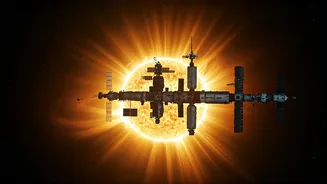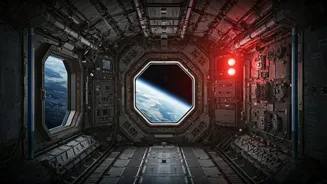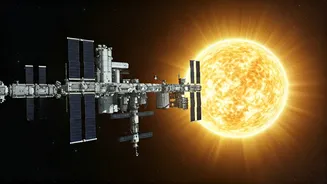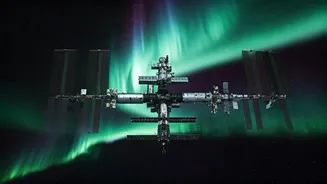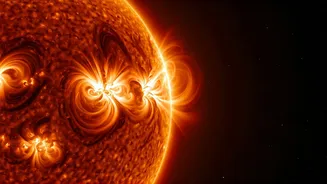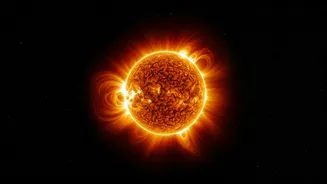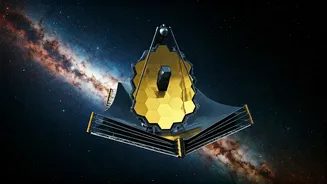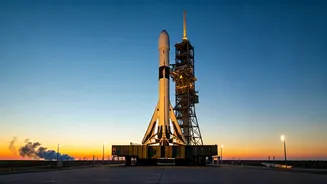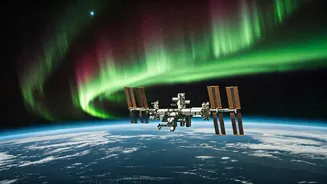Solar Storm Unveiled
Solar storms are sudden disturbances on the Sun, often resulting from solar flares and coronal mass ejections (CMEs). These events release vast amounts
of energy and charged particles into space. CMEs are particularly impactful, expelling billions of tons of plasma at high speeds. When these ejections reach Earth, they can interact with our planet's magnetic field, causing geomagnetic storms. These storms can disrupt communications, damage satellites, and, most importantly, pose a radiation risk to astronauts in space. The intensity of solar storms can vary greatly. The recent event triggered safety protocols on the ISS. Astronauts moved to shielded areas of the station, protecting them from the surge of radiation.
ISS: Safe Haven
The International Space Station (ISS) is equipped to handle such events. The ISS’s design includes specific areas and measures for protection against radiation. During a severe solar storm, astronauts are directed to these shielded modules. They are constructed with materials that provide extra protection against high-energy particles. The primary objective is to minimize exposure to radiation, thereby mitigating potential health risks such as radiation sickness or an increased long-term cancer risk. The protocols implemented on the ISS reflect years of research and preparation. They are constantly reviewed and updated to account for new understanding of space weather and its effects on humans. The ISS serves as a vital laboratory and living space. Its ability to shield astronauts from the extreme environment of space ensures the sustainability of scientific endeavors and human exploration.
CMEs: The Culprits
Coronal Mass Ejections (CMEs) are massive expulsions of plasma and magnetic fields from the Sun's corona. They are the primary drivers of severe space weather events. When a CME erupts, it can hurl billions of tons of solar material into space at speeds of millions of kilometers per hour. If a CME is directed toward Earth, it can reach our planet in as little as 18 to 36 hours. The impact of the CME on Earth's magnetosphere can create geomagnetic storms. These storms can disrupt radio communications, GPS systems, and power grids. They can also cause auroras (the Northern and Southern Lights). The strength of a CME and its direction influence the severity of the geomagnetic storm. Scientists constantly monitor the Sun to predict these events and provide advance warnings, which allow the necessary precautionary measures to be taken.
Protecting Astronauts
The primary concern during a solar storm is the health of the astronauts. High levels of radiation can penetrate the human body and damage cells, increasing the risk of both short-term and long-term health problems. To mitigate the risks, astronauts follow established safety protocols. These include seeking shelter in the most shielded areas of the ISS. These areas often feature additional layers of protection, such as water tanks and storage areas, that can absorb radiation. Astronauts might also wear radiation-detecting devices to monitor their exposure levels. Mission control on Earth also plays a crucial role. They provide real-time updates and guidance, informing the astronauts on the evolving radiation environment. The combined efforts of ground control and the safety features built into the ISS play a critical role in preserving the astronauts’ well-being during intense solar activity.
Earth's Magnetic Shield
Earth is fortunate to have a natural shield: its magnetic field. The magnetosphere deflects most of the charged particles from the solar wind and CMEs. However, during intense solar storms, the magnetosphere can be overwhelmed. This leads to geomagnetic disturbances that can affect our technology. Satellites in orbit are especially vulnerable because they are directly exposed to the harmful effects of solar radiation. Operators must take protective steps, such as powering down sensitive equipment. The magnetic field also influences auroras, which appear in the upper atmosphere. The location and intensity of auroras are affected by the severity of the geomagnetic storm. Understanding the intricate dynamics between the Sun, the Earth's magnetic field, and the solar wind is critical. These insights aid in enhancing the reliability and safety of space missions and modern technologies.
